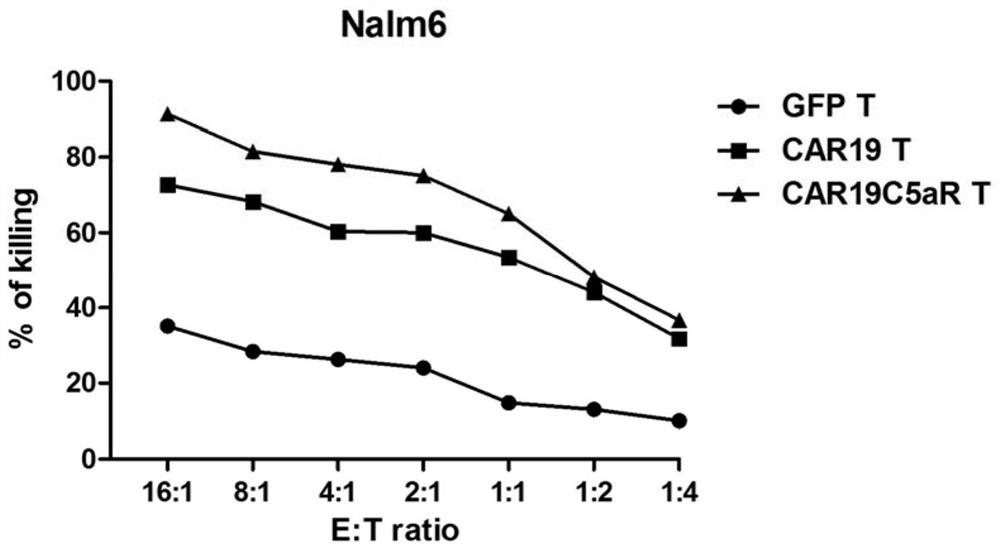Chimeric antigen receptor containing c5ar intracellular domain, lentiviral vector, expressing cell and drug
A technology of chimeric antigen receptor and intracellular domain, applied in the direction of receptor/cell surface antigen/cell surface determinant, anti-receptor/cell surface antigen/cell surface determinant immunoglobulin, virus/phage, etc. , can solve the problems that the effect of chimeric antigen receptor cannot be expected, and the clinical results have not been shown, so as to improve the killing effect, increase the killing efficiency in vitro, and eliminate the effect of immunosuppression
- Summary
- Abstract
- Description
- Claims
- Application Information
AI Technical Summary
Problems solved by technology
Method used
Image
Examples
Embodiment 1
[0033] Example 1 Preparation of plasmid containing anti-CD19ScFv-4-1BB-CD3ζ-C5aR (CAR19C5aR)
[0034] Prepare the plasmid of the present invention carrying the chimeric antigen receptor gene containing the intracellular domain of C5aR as follows:
[0035] (1) The plasmid pUC57-CAR19 containing anti-CD19ScFv-4-1BB-CD3ζ (CAR19) was obtained by means of gene synthesis and molecular cloning, including anti-CD19 monoclonal antibody ScFv, CD28 transmembrane region and 4-1BB, CD3ζ intracellular region , namely CD19ScFv-4-1BB-CD3ζ.
[0036] (2) The resulting pUC57-CAR19 plasmid was digested with endonucleases Pmel and Sepl to obtain the CAR19 gene, and then the CAR19 gene was connected to the lentiviral vector pWPXLd-GFP to construct pWPXLd-CAR19-GFP.
[0037] (3) Digest the obtained pWPXLd-CAR19-GFP plasmid with endonucleases NotI and SpeI to obtain the intracellular fragment 4-1BB-CD3ζ of the CAR19 gene.
[0038] (4) Using the cDNA of 4-1BB-CD3ζ tandem C5aR intracellular signaling...
Embodiment 2
[0041] Lentiviral packaging of embodiment 2CAR plasmid
[0042] Three lentiviruses expressing GFP (blank control), CAR19-GFP (control), and CAR19C5aR-GFP respectively were obtained by using the CAR plasmid of the present invention prepared in Example 1 and related control plasmids through lentiviral packaging. In Examples 2 and 3, the CAR-containing plasmid is collectively described as pWPXLd-CAR-GFP plasmid, and the CAR-overexpressing lentivirus is collectively described as CAR lentivirus.
[0043] Specific steps are as follows:
[0044] (1) Cultivate 293T cells in a 10cm culture dish, the culture medium is: DMEM high glucose medium + 10% FBS (fetal bovine serum) + 1% double antibody (100 × penicillin-streptomycin mixed solution);
[0045] (2) When the 293T cell density in the 150mm culture dish reaches 80-90%, replace the medium: DMEM high glucose medium + 1% FBS + 1% double antibody;
[0046] (3) After replacing the medium and culturing for 2-6 hours, the two plasmids pWP...
Embodiment 3
[0055] Example 3 Using packaged CAR virus to infect human T cells
[0056] (1) Separation and purification of T cells: the mononuclear cells in the blood are separated by the Ficoll density gradient method, and the red blood cells are removed by lysing with the red blood cell lysate, and then the T cells are sorted by MACS Pan-T magnetic beads;
[0057] (2) The sorted T cells were diluted with culture medium (AIM-V medium+5% FBS+penicillin 100U / ml+streptomycin 0.1mg / ml) to a cell concentration of 2.5×10 6 pcs / ml for use;
[0058](3) Stimulate T cells by magnetic beads coated with CD2, CD3, and CD28 antibodies (product source: Miltenyi, Germany), that is, the coated magnetic beads and T cells are mixed at a ratio of 1:2, and the final density of T cells should be 5 ×10 6 A / ml / cm2. After mixing, place them in a 37°C, 5% CO2 incubator to incubate and stimulate for 48 hours.
[0059] (4) Lentiviral transfection of T cells: remove the magnetic beads in the activated T cell-magn...
PUM
 Login to View More
Login to View More Abstract
Description
Claims
Application Information
 Login to View More
Login to View More - R&D
- Intellectual Property
- Life Sciences
- Materials
- Tech Scout
- Unparalleled Data Quality
- Higher Quality Content
- 60% Fewer Hallucinations
Browse by: Latest US Patents, China's latest patents, Technical Efficacy Thesaurus, Application Domain, Technology Topic, Popular Technical Reports.
© 2025 PatSnap. All rights reserved.Legal|Privacy policy|Modern Slavery Act Transparency Statement|Sitemap|About US| Contact US: help@patsnap.com



